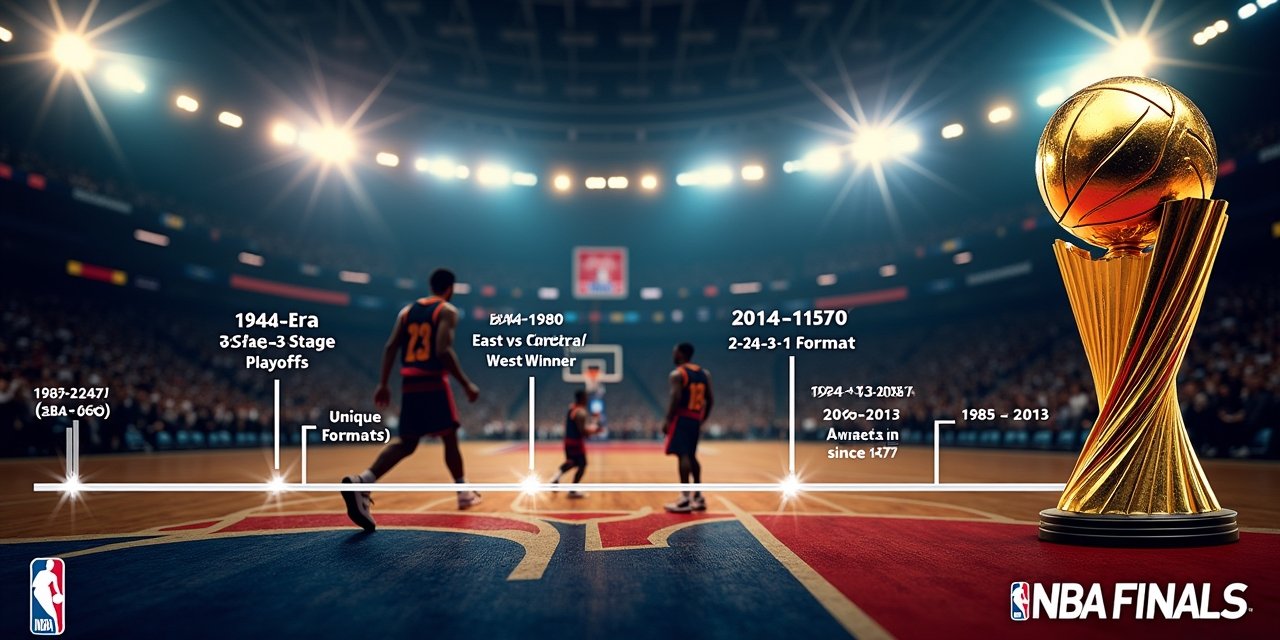Key Highlights
- The NBA Finals, the pinnacle of basketball, decides the annual league champion between the top teams from the Eastern and Western Conferences in a best-of-seven matchup.
- Over the years, the Finals structure evolved from divisional matchups in the Basketball Association of America to the current conference format introduced in 1970.
- The championship trophies transitioned from the Walter A. Brown Trophy to the iconic Larry O’Brien Championship Trophy.
- Home-court advantage and series formats have significantly impacted game strategies and outcomes.
- Various series formats, including 2–2–1–1–1 and the experimental 2–3–2, have shaped the event’s history.
Now, let’s explore the NBA Finals’ fascinating journey through time.
Introduction
The NBA Finals is the top event in basketball. It comes from the history of the Basketball Association of America, and now it is the championship series in the National Basketball Association. Since it began, the NBA Finals have always brought out the best players in the game. The format has changed as time passed, and there have been many great moments. Every year, people watch, and the winner gets the title. Over time, this event has added to the rich story of sports. If you want to know more about nba history, let’s take a closer look at the national basketball association, the basketball association of america, and the championship series.
The Evolution of the NBA Finals: A Historical Overview
The NBA season, and the NBA Finals, started out in a much simpler way than what we see today. At first, the league was called the Basketball Association of America, or BAA. At that time, the playoffs did not have many parts. The teams just played a short, three-stage tournament to win.
By 1950, there was a big switch in how things worked. The top team from the Eastern Division faced the team that won between the Western Division and the Central Division. This format looked different from what we see now.
The biggest change happened in 1970. The NBA then started using the conference system. Now, the champion of the Eastern Conference played against the winner from the Western Conference. This setup is the one all people know, and it still shapes the way teams go after a championship today. Now let’s look at how it all began in those first few years.
1946–1949: BAA Beginnings and Initial Format
The NBA Finals started when the league was still called the Basketball Association of America (BAA). At that time, the playoffs had three parts. Two winners from the semifinals went on to play for the first championship in a best-of-seven games series. This early setup helped shape what people today see as the main event in professional basketball.
The Minneapolis Lakers became an important team in this period. They won their first championship in the 1948–49 season. That season was also the last one for the BAA, and it followed the Philadelphia Warriors’ championship victory. Players like George Mikan made the Lakers so strong that their names are known by all in basketball history.
In 1949, the BAA joined with the National Basketball League, creating the NBA. This move made way for the league to grow and change, leading to the Finals people watch now. The NBA went from teams winning in divisions to teams from different conferences facing off, which was the next big step.
1950: Unique Competition Year
The year 1950 stands out in NBA Finals history as a notable moment in the NBA championship landscape. That season, the NBA used a one-of-a-kind playoff format. The Eastern Division winners, the Syracuse Nationals, faced a team from a playoff between the Western and Central Division champs. This playoff was between the Minneapolis Lakers and the Anderson Packers.
After these games, the Nationals met the Minneapolis Lakers. This was a tough series. The Lakers used their playoff skills and won. With help from George Mikan, the Minneapolis Lakers and the Washington Bullets won their second NBA title in a row. This marked them as a great team at the time.
Although the Lakers took the win, the strange format used that year was never seen again. The 1950 Finals showed just how deep and strong every division was when it came to the nba finals. This made people talk about how playoffs should work in the future. That year showed the nba moving from old ways toward a better and more stable setup.
1970–Present: Eastern vs. Western Conference Battles
In 1970, the NBA moved to its current setup. Now, the teams are split into the Eastern and Western Conferences. The Championship Finals started to show this new setup. This change built a tradition where the best teams from both sides would face each other.
These matchups gave the fans some of the most exciting games to watch. Teams like the Boston Celtics and Los Angeles Lakers played in many NBA Finals games during the years. Whether it was the Celtics with Larry Bird or the Lakers with Magic Johnson, these events did a lot to change the way people think about basketball. They also helped make the history of the sport.
Now, the NBA Finals are still a huge moment in basketball every year. Games such as the 2016 matchup between the Cleveland Cavaliers and Golden State Warriors have made strong memories for fans. Using the conference system has made games more exciting. The fans get to see the best of the best go up against each other. This keeps NBA Finals games as the top thing to watch in basketball.
Trophies Over Time: From Walter A. Brown to Larry O’Brien
The NBA Finals trophies have changed over the years as the league has grown. From 1947 to 1976, the team that won the championship got the Walter A. Brown Trophy. This trophy be tied to the start of the league and showed its hopes to get bigger.
In 1977, the Walter A. Brown Trophy was replaced with the Larry O’Brien Championship Trophy. Tiffany & Co. made the new design. This change stood for a new, modern look in the league. In 1969, the Finals MVP Award was added. This brought extra light to players who were the best in the championship series.
| Trophy Name | Years Used | Notable Recipient Years |
|---|---|---|
| Walter A. Brown | 1947–1976 | Minneapolis Lakers (1954) |
| Larry O’Brien | 1977–Present | Cleveland Cavaliers (2016) |
Trophies are still seen as the top honor, loved by players and all the fans. They mean victory and show the story of the league.
Home-Court Advantage and Its Impact on Game Outcomes
Home-court advantage has always played a big part in who wins in the NBA Finals. In the newer 2–2–1–1–1 format seen since 2014, the team with the better regular season record gets to host Games 1, 2, 5, and 7. This setup lets them play in a place they know well.
When you look at stats from past years, it is clear that teams, especially the only team to win, with the home-court advantage do better in most cases. For example, the San Antonio Spurs showed how important this can be when they took down the Miami Heat in 2014. They started out strong and kept it up for a clear win. To have the best record makes a team start in a stronger spot.
This lesson is not lost on teams. They try even harder during the regular season to get that key edge. People know that home-court advantage gives more than just a good spot on the schedule—it actually affects the end results in the NBA Finals in a big way. Now, people want to see how it may shape next year’s playoffs.
Significant Changes in Series Formats Through the Years
Over the years, NBA Finals history has seen many changes in the series format, including the first round which was 2–2–1–1–1. It gave higher-seeded teams a better chance because they played more home games.
From 1985 to 2013, there was a 2–3–2 format. This setup was new and not used before. It helped with travel and planning. But many people said it helped the team with fewer wins get more chances. Changing the formats over time has affected how teams try to win and how every NBA Finals ends. These changes made the Finals what we know them as today. Let’s look at the way formats have changed in NBA finals history.
Original Format: 2–2–1–1–1
The 2–2–1–1–1 format used in the NBA playoffs is made to be fair and smart. Teams take turns playing home games, which helps to split advantages equally as the rounds go on.
In past playoff series, this worked well. When the first championship was played with this format, the Syracuse Nationals and Minneapolis Lakers both got chances to use their strengths at home. Many NBA playoffs games, especially near the end, used this way of scheduling to keep things fun and exciting for people watching.
When the NBA went back to the 2–2–1–1–1 setup in 2014, it showed that this way is good at making both fans happy and letting teams plan better.
The 2–3–2 Era: 1985–2013
Starting in 1985, the NBA switched to the 2–3–2 structure. It did this to make travel easier. The team with the better record got to play Games 1, 2, 6, and 7 at home.
But this setup made a big impact on the championship series. Some teams had a hard time when they had to play three games in a row away from home. The Miami Heat went through this tough spot against the Chicago Bulls in 2011.
As time went by, more people saw that this format was not fair. This led the NBA to leave this setup behind. By 2014, all the problems were clear. That is when the league decided to go back to the 2–2–1–1–1 structure, giving a more even chance to every team.
Alternating Home Court: 1–1–1–1–1–1–1
The 1–1–1–1–1–1–1 format switched the home court every game. This was made to help fairness for all. But the travel between games made it hard for players. It was tough for them to do their best.
Some of the best teams, like the San Francisco Warriors, tried to change up their plans to work with this format. But teams with better regular season records still did well most of the time. So, just doing things in a new way did not always help if you do not have a strong team.
In the end, they stopped using this format and went with playoff series setups that fans liked more. Still, it showed something important. People who plan game tactics pay attention to how different formats need new ways to win again and again, even now.
Experimenting with Formats: 1–2–2–1–1
The NBA Finals tried a 1–2–2–1–1 game setup in 1975 and 1978. This meant one team got to play at home only once at the start, then got some changes as the games moved on. The way the games were set up was a bit different than before.
Teams like the San Antonio Spurs played against the Cleveland Cavaliers with this setup. The San Antonio Spurs, Cleveland Cavaliers, and the Dallas Mavericks both had to find the right mix of pushing forward and strong defense in these games. But, because the series could be hard to guess, players sometimes lost their usual game flow during these NBA years.
This test with a new format did not last long, but it gave more character to Finals history. It showed the league wanted to try new things to keep games fair and get people interested.
Conclusion
The NBA Finals have changed a lot over the years. This shows the long and interesting story of pro basketball. The Finals started when the league was called the BAA. Now it is a big fight every year between the best teams from the Eastern and Western Conferences. These games have kept changing, making things better for both the teams and people who love the game.
If you know about the different ways the Finals were set up, and big moments like when the Walter A. Brown Trophy was replaced by the famous Larry O’Brien Championship Trophy, you start to see why every championship fight is special. When we watch this big event each year, it is good to remember how these changes have built the sport’s past and will also guide its future. If you want to find out more about the NBA Finals, or keep up with the latest playoff news, make sure to check out our blog!
Frequently Asked Questions
What determines the home-court advantage in the NBA Finals?
The team that has the better regular season record gets to play more games at home during the NBA Finals. This means the team will host the first game, the important fifth game, and the last seventh game if needed. Having home-court advantage can help a team win, because this often makes a big difference in who comes out on top.
How has the format of the NBA Finals influenced championship outcomes?
NBA Finals history shows that the way a playoff series is set up can change how teams play. The NBA Finals format used to have a 2–3–2 format, but now uses a 2–2–1–1–1 style. Teams change their ways to deal with travel and keep things fair. These changes have had a big effect on the results of many playoff series in the past.
What are some memorable NBA Finals series and their significance?
Some NBA Finals games are truly unforgettable. The 2016 Cavaliers vs. Warriors series stands out as one of the best in the United States. In this championship series, LeBron James showed complete dominance. Kyrie Irving also had a few clutch plays that people still talk about. There were many big and iconic plays that made this showdown special.
In the NBA Finals games, players like James Harden have also made their mark. His standout performances in key moments show how one person can change a whole championship series. These Finals remind us how important it is to have great players like LeBron James, Kyrie Irving, and James Harden when it matters most.







